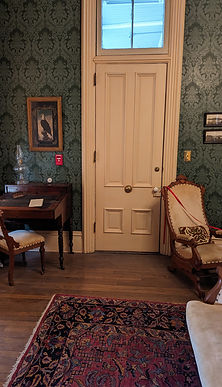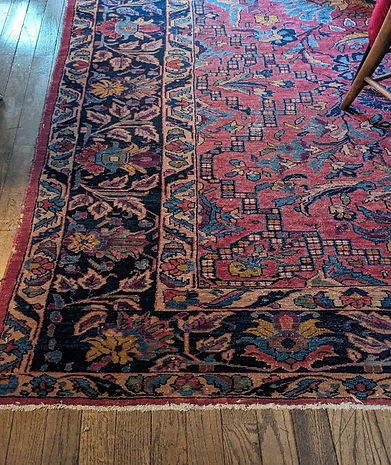The Hamilton County Historical Society relies on the generosity of our community to thrive. We invite you to contribute to our mission of preserving local history and making it accessible to everyone. Clicking on the button will take you to our secure checkout with Square.
The Parlor
Like most parlors in the day, ours is located at the front of the home.
Parlors were intended for special occasions. Children dare not tread into the parlor. The parlor was typically the only room in the home that had a large carpet.
The room may have been kept locked for most of the winter months when not in use so they did not have to heat it. Most parlors either a piano or organ in the room. We are fortunate to have a Kimball pump organ




Kimball Pump Organ
Kimball (W. W.) Co.
William W. Kimball, a native of Maine, moved from Iowa to Chicago in 1857, when he was 29 years old. Kimball made a living by renting pianos and selling sheet music. By the 1870s, his music store reported annual sales of nearly $1 million. At the beginning of the 1880s, Kimball opened his first factory, which made organs and pianos, at 26th and Rockwell Streets. By 1900, W. W. Kimball & Co. employed about 1,500 people at this facility. By the 1910s, the company was turning out more than 13,000 pianos each year, making it one of the top 10 manufacturers in the U.S. piano industry. During the 1950s, when it moved its main plant and general offices to suburban Melrose Park, the company continued to employ hundreds of Chicago-area residents. In 1959, Kimball was purchased by the Jasper Corp. of Jasper, Indiana, a maker of television cabinets; the piano plant moved to West Baden, Indiana. In 1974 the name of Jasper Corp. became Kimball International Inc.; at the end of the century, this company was still making Kimball pianos.
WW Kimball made 13 types of pump organs. This type is fittingly called the parlor organ.
Wilson, MR January 18, 2024. Encyclopedia of Chicago, http://www.encyclopedia.chicagohistory.org/pages/2740.html
About The Pump Organ
Pump organs are interesting musical instruments.
Human beings have always been interested in creating a culture wherever they ended up settling, and we see that this isn’t limited to a particular region or part of the world. Of course, they came up with their own instruments and unique instruments, as well. Many people might not be familiar with the pump organ, but it has quite a rich history that can’t be denied.
One of the reasons that pump organs gained popularity centuries ago is because they were often times more portable than pipe organs. It became a staple of many affluent homes, and some churches ended up adopting pump organs rather than pipe organs, as well. A pump organ is also called a “harmonium.”
The pump organ ended up being replaced by the electric organ, but it had several decades of popularity. You can still find it being used by certain musicians, but you are not as likely to hear a harmonium in modern times. However, it is still used in Indian music and Pakistani music.
The pump organ works by pushing air past a piece of thin metal (called a “reed”). It should be noted that while a pump organ can sound incredible, it is somewhat limited in tone. The pump organ was most popular between 1850 and 1930. You can hear the pump organ in the work of many classic artists, from Debussy, to Bach, to Franz Liszt.
From The Keyboard Experts, January 24th, 2024 https://www.pianoorganrepair.com/a-brief-history-of-pump-organs
Parlor Fireplace
In 1978, our museum underwent a huge renovation. From 1972 to 1977 the home was only used as a jail and sheriff office. They had taken over the family portion of the home for much needed office and jail space. The before and after of this fireplace shows the great strides that we made in getting back as closely as we can to the original look of the residence. The room was usually cold and originally fires were started with coal. In the 1880's there was a natural gas boom in Indiana, and the fireplace would most likely have been converted at that time.




The Family Bible –
The original
Ancestry.com
Prior to easily retrievable birth certificates, marriage licenses, death certificates, and digitized record keeping in general, the family Bible held the ultimate narrative of ancestral history.
They are a treasure trove for both genealogists and historians.
Often, the family Bible was the only written record of births, marriages, and deaths of loved ones. In addition, between the leaves of this precious possession one could expect to find a wealth of newspaper clippings, letters, photos, and other ephemera pressed for safekeeping over generations of forbears.
It was understood that the book was to be carefully guarded and passed along.
Source: https://www.appalachianhistory.net/2019/09/family-bible.html
Parlor – Wool Rug
By the late 1700s, an important innovation occurred: the ingrain carpet. These bold flat-pile wool floor coverings were made on a more sophisticated loom that could produce elaborate geometric and floral patterns. The most popular colors were red, yellow, and green.
Since ingrain carpets were machine-made, they were relatively affordable and were found increasingly in middle-class homes. Ingrain carpets retained their popularity well into the 1800s.
We are fortunate to have a wool rug for our parlor in such great condition considering it is most likely over 150 years old.
We love that the colors are still so vibrant and beautiful.
American author Edgar Allan Poe is best known for his mournful poetry and eerie short stories. He also had plenty to say about what we today call interior design. In an 1840 essay about interior decorating, Poe states,
“A carpet is the soul of the apartment.”

.jpg)
